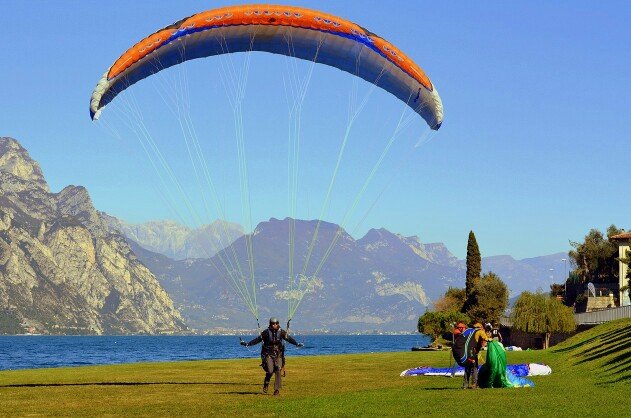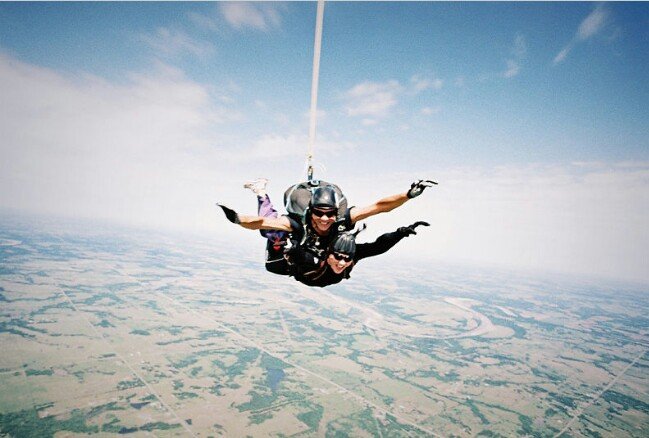Its a Beautiful Day and its such a Great time to explore the world of Engineering. So If you are like me, I'm sure you have a long list of things you would like to experience or accomplish before you die. Amongst other things on my long list one of the most exciting is Skydiving
Have you ever imagined skydiving?
There is just something super cool and exciting about leaping from a plane and falling through the air at about 120 miles per hour, that indescribable feeling you have when one is free falling as air rushes by is one of the best feeling one would ever feel.
Sounds really Exciting, scary and dangerous...right?
Like most people you probably have some mixed feelings about skydiving. But have no fear because once you reach terminal velocity after jumping off the plane, you simply launch your parachute and slowly descent as you travel back to earth, that way you would touch down safely with ease and not hurt yourself.
So today my post would be about this superb innovation... Parachutes

A parachute is a simple piece of technology that has different settings engineered for specific purposes depending on their use. They are used for activities ranging from military to recreational activities. With the advancement of technology parachutes continue to evolve, now pilots can effortlessly turn their parachutes, change the rate of descent of the parachute at any time during the flight, flatten their glide and do so much more thereby ensuring more accurate landing and making them easier and safer to use.
Parachutes are one of the simplest and most effective inventions for ensuring the safety of lives on aircrafts. For people that are on board a plane that is equipped with parachutes, when there is engine failure several miles above the ground, instead of just panicking, screaming or closing their eyes to say their last prayer. They immediately Eject yourself from your seat, take a parachute, then patiently wait for the plane to fly clear before they leap out of the plane and hit their parachute, this way they glide safely to the ground.
In fact, some aircrafts make use of parachutes recovery system to serve as a protective feature to protect the aircraft from crashing. In this type of aircraft when the pilot notices he has lost control of the aircraft he pulls a huge red lever in the plane to activate the parachute, so the plane can glide gently to the ground instead of crashing.
Ever heard of this drag racing? If you have you already know the vehicles used for this races are super-fast and it takes space and time for them to slow down. So they make use of specialized parachutes known as drogue chute horizontally instead of vertically, to reduce the length of track required to slow the vehicles down after racing.
Another recreational use of parachutes is for parasailing which involves a person with a parachute being pulled behind a boat.
Parachutes are not just meant for slowing down the movement of people alone, Larger Parachutes have more surface area, that is used to trap air molecules and cause greater drag and that’s why military makes use of them to deliver supplies, equipment and cargo to troops in remote areas. They also use parachutes to drop soldier in certain locations, this way there is no need for a landing strip for the plane.

Now let’s take a brief look at the major component of a parachute
Parachutes are designed in such a way that every component carries its own share of the maximum load that is applied during the opening shock. A standard parachute has five main components which are the pilot chute, main Canopy, Suspension Lines, Harness and Pack.
A parachute has three chute packed into the backpack (the container). There is a main chute known as the canopy, a reserve parachute for situations where the main parachute fails and a small chute at the bottom of the container known as the pilot chute
The main part of the parachute is the CANOPY. It’s the part of the parachute that balloons outward as the payload begins to fall and it has a top vent that allows a slow escape of air thereby preventing air from leaking out of the sides of the canopy. While the pilot chute anchors itself in the air stream then pulls out the remaining components from the parachute pack. The pilot chute is connected to the main parachute by the Bridle
The weight of the parachute is spread evenly across the canopy using the suspension lines, which run continuously from the connector link from one side through the canopy to the connector link on the other side. The part of the parachute worn by skydivers that holds the packed up parachute together is the harness and container
Once the pilot chute is triggered either by pulling on a ripcord or by throwing the pilot chute into the air, it rapidly opens behind the user, this creates enough force to tug the main chute from the container of the parachute.
The design of the parachute ensures that the main chute opens in a delayed form so that the user’s body does not get jerked suddenly and too quickly, this ensures the safety and comfortability of the user as well as reducing the risk of the parachute ripping or tearing. Also the packaging of the main chute inside the container is paramount, so the ropes that connects the suspending lines open correctly and straighten out behind the user
As the parachute is deployed, this is the order in which it comes out from the pack: the pilot chute, the canopy, the suspension lines and the risers. Once it is fully deployed the Control lines are used for steering and braking

Operation of a parachute
Parachutes slow down the gravity driven fall of an object or person. The operation of a parachute is as result of Air Resistance. Air resistance acts against gravity and without air resistance gravity would make Everything fall at virtually the same rate.
I Remember this short experiment we perform in junior secondary school, where our science teacher tells us to drop a feather and a stone from a certain height, from this experiment we realized that the stone would hit the ground first.
Although gravity pulls on all object equally, but some objects would fall faster than others based on the properties of the falling object. So in this case the stone is obviously heavier and has a smaller surface area thereby it pushes the air molecules out of the way more quickly while feathers cannot push the air molecules out of the way easily because they weigh less and they have a larger surface area so the air slows the feather down. But without air resistance they would hit the ground at the exact same time
When a person jumps from an aircraft without a parachute, the relative compact body would move through the air like a stone but once the parachute is used, as soon as it unfolds and opens out behind the diver it immediately traps air molecules thereby lowering the terminal velocity of the skydiver by increasing the air resistance as the diver falls by creating a large surface area with a huge amount of drag. So the parachute slows the skydiver down, till the diver safely hit the ground much more like a feather
Practically After a few seconds of jumping off a plane. The force of air resistance that pushes the person forward increases so much that it balances the force of gravity that pulls the person downward, the person keeps falling at a steady speed called terminal velocity because there is no net acceleration at this point. So a Parachute basically operates by creating a structured wing for passengers to fly under by forcing air into the front and they can be controlled by changing the shape of the wing by pulling down the steering lines, making the parachute turn, increase or decrease its rate of descent as the case may be.
For the parachute to perform effectively they are packed into their containers such that as the parachute are deployed the cells point forward allowing air to rush into the parachute immediately. Having this type of design in place ensures that the parachutes always open efficiently and flies front first, because any slight variance in the packaging of the parachute could result in off-heading openings.
The greater the drag generated by the parachute, the more slowly a person or object attached to the parachute will descend because a parachute is a semi rigid wing such that when they are flying they are still quite solid. A full parachute is a series of separate chambers, and they all catch air and work together to make the full wings. When the parachute flies forward, air is rammed in through the front and caught inside the cells ensuring the parachute gets its shape.

Movement of the parachute
Taking a look at a parachute, you would realize that strong string or ropes are attached at various points across the parachute’s underside to connect the parachute to its container
The parachute has steering lines which are mostly located at the back of the parachutes, toggles are attached to the bottom of the steering lines to serve as handles so the diver can hold for ease of control.
For the parachute to turn, these steering lines can be pulled down on both side or one side to make a turn. For instance, when the diver pulls down the right steering line the parachute turns right and the same thing happens when the diver pulls down on the left steering line, the parachute goes left however when the diver pulls both the canopy flattens out and slows down the rate of descent of the canopy.

Image of a Skydiver landing using a parachute from pixabay under CCO license
For the skydiver to touchdown successfully on land, the parachute descent is slowed down to its minimum. To achieve this the sky diver pulls down on both steering toggles in a controlled but assertive way, this pulls down on the back of the parachute to flatten out the parachute, thereby reducing its overall descent rate to almost nothing. So the skydiver usually takes a gentle step forward to touchdown as air stops rushing into the parachute, it collapses to the ground.

CONCLUSION
A parachute is a simple piece of technology that is used for activities ranging from military to recreational activities. They are not just used to slow down the movement people alone they can also be used to deliver supplies, equipment and cargoes to remote location.
Anyway If you have a bucket list I suggest you include skydiving to that list, it would be a worthwhile experience.



nice write up, though sky diving isn't something ill be eager to do now or in the foreseeable future, its too scary for me
Hahaha.... Trust me! It would be worthwhile!
Hi @steematlas!
Your post was upvoted by utopian.io in cooperation with steemstem - supporting knowledge, innovation and technological advancement on the Steem Blockchain.
Contribute to Open Source with utopian.io
Learn how to contribute on our website and join the new open source economy.
Want to chat? Join the Utopian Community on Discord https://discord.gg/h52nFrV